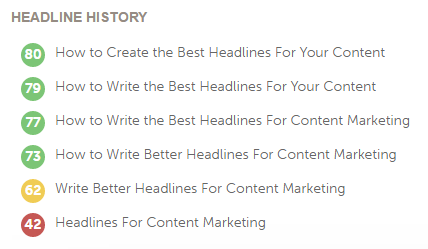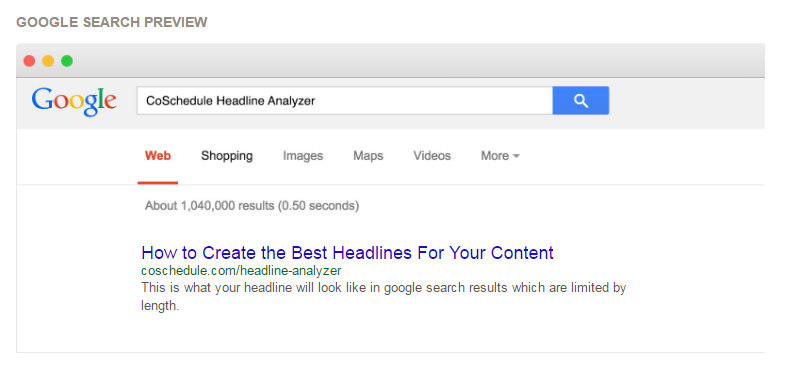Without the right headline, even the best content is likely to go unread, so if you can’t create a killer title that grabs people’s attention, the rest of your work will go to waste. Writing great headlines takes time, and even the world’s top copywriters draft and redraft titles until they have the perfect composition to pull readers in.
Recipe for a great headline
Creating top-notch article titles takes practise, but all powerful headlines share a few common ingredients. Remember, though, that a recipe is only as good as the cook, and you’ll need to work hard to come up with headlines that really stand out.
Give people a reason to click
People need a reason to read on. How is your content going to benefit them? What questions will it answer? What problem will it solve? Make it clear what you’re giving them, and why they need it. If you can show that your content will affect their lives, you’ll draw them in.
Bad: “Easy Tips for Redecorating Your Home” – It’s a fair description of the article, but there’s no emotional engagement as to why someone might be redecorating their home.
Good: “Sell Your Home Faster With These Easy Decorating Tips” – This headline tells people how they’ll benefit from reading on.
Make it personal
Creating a headline that speaks to the reader immediately involves them. Use your knowledge of what the audience is looking for to write a headline that speaks to their motivations. For instance, as a digital content marketing agency we produce content that targets, amongst others, marketing directors of small businesses, who are valuable potential customers. Knowing that, we create headlines which match up with their motivations.
Not so good: “Content Marketing Tips for Small Businesses” – Completely accurate, but it isn’t speaking directly to the reader. It’s generic and could be referring to anyone’s business.
Much better: “Content Marketing Tips to Grow Your Small Business” – This headline addresses the reader directly – it’s your small business, and we can help it grow.
Reverse expectations
There is a lot of content online, billions of pages, so instead of jockeying for position with dozens of similar titles, try to attack the topic from an unexpected angle – a fresh approach is instantly engaging. An easy way to do this is to flip the topic on its head; instead of saying why your product is good, try highlighting the problems which others might experience with competing products.
Bad: “10 Reasons Your Business Needs Better Copywriting” – You might have some very good points, but this title comes across overly advertorial and there will be countless other very similar articles already out there..
Good: “10 Signs Your Business Needs a New Copywriter” – Straight away, this headline provides a more engaging premise. The content itself might be almost identical, but by framing it in an alternative context we provide a fresh approach.
(N.B. If your business does need a new copywriter, you could always check out our content writing and web copy creation services…)

Use emotional triggers
Engaging a reader’s emotions is a powerful way to capture attention. Surprisingly, negative emotions have been shown to be more engaging than positive ones, in the same way that bad news sells better than good news.
Not so good: “Use Content Marketing to Reach Your Target Market” – This headline doesn’t say anything particularly exciting or engaging; there’s no emotional charge.
Much better: “Without Content Marketing, You Can’t Reach Your Target Market” – Here, there’s a distinct negative emotional attachment; failing to reach your target market is a worrying thought for marketers, driving them to engage with this article.
Deliver on promises
Clickbait articles over-promise and under-deliver. Their headlines will say whatever they need to in order to get your click, even if they massively oversell their content. If you’re chasing clicks, that’s great, but if you want to actually engage readers then you need to choose a headline that’s appropriate for your content.
This isn’t to say you shouldn’t try and sell your content to readers; that’s the whole point of a headline. However, if you go overboard then you’re likely to lose readers once they discover that the content doesn’t match up.
Bad: “You Won’t Believe What Content Marketing Can Do For Your Business!” – Aside from being a little cheesy, it’s unlikely that whatever you’re going to tell them is really unbelievable. If your content leaves readers underwhelmed, they certainly won’t feel like sharing it around, which is the content marketer’s goal.
Good: “How to Make Bigger Profits with Better Content Marketing” – This is still a bold claim, but one which can be backed up with some solid advice. If you can meet the expectations set by your headline, you’ll find your article being shared and referenced.
Using Tools to Check Your Headline
It can be tough to choose between one headline and the next, but CoSchedule’s Headline Analyzer makes your job a lot easier. This useful site grades your headline according to several criteria, presenting a score which reflects how likely it is to appeal to readers.
This makes it easy to refine the content of your headline. Compare my first headline below with the final one (at the top); by adding a few extra words and changing the tone of the headline, I was able to boost the score from a miserable 42 to a healthy 80.

A high score on this tool doesn’t guarantee that your headline will perform well, though, and just because it says that “How to Create the Best Headlines for Your Content” is marginally better than “How to Write the Best Headlines for Content Marketing” doesn’t mean it will perform any differently. Remember, all it’s doing is checking your title against a list of rules and scoring it accordingly – you have to be the final judge of whether it’s a good title or not.
Another useful section of the headline analyser is in the search preview. This shows how your headline will be displayed in a Google results page, helping you to visualise it in context. You can also see whether it will be shortened to fit within the Google result, which can be difficult to predict otherwise.

Since Google devotes only a certain number of pixels to each result, headlines which use characters that take up more space (such as w, m, o and e) might be chopped off earlier than ones which use small characters (like i, t, l and j). As a general rule, you should aim to keep your headline between 50-60 characters to avoid truncation.
Headline Round-up
When you’re writing a headline, remember these key points:
- Make it emotional
- Make it personal
- Deliver on your promises
- Reverse expectations
- Show how the content will help
If your headline doesn’t tick any of these boxes, you need to go back and redraft until you have something that’s truly engaging and interesting.
Remember, without a great headline, anything you write is likely to go unread. Spending time coming up with the best possible headline will pay off as your content becomes shared, referenced and (hopefully) enjoyed.
If you’d like further guidance on creating content that delivers a punch, please contact us to arrange a meeting.
If you have any comments or questions about this post, or would like to discuss a specific issue with your site, please get in touch using the form below.
And connect with us on social media to stay upto date with our latest news:

